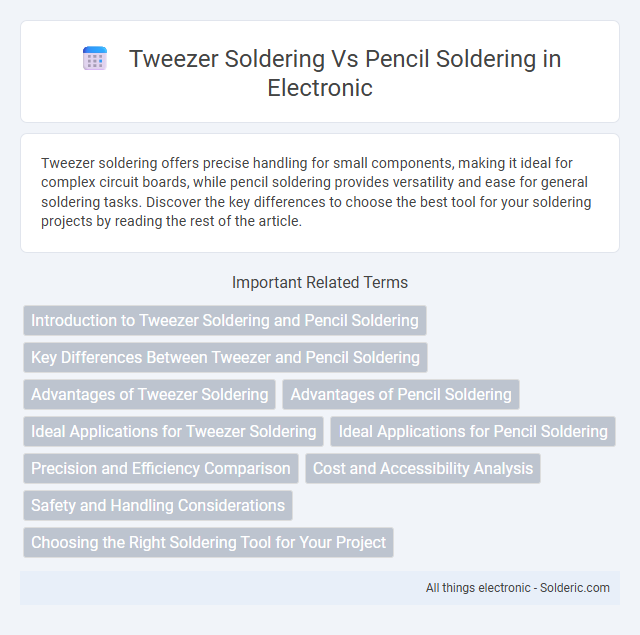Tweezer soldering offers precise handling for small components, making it ideal for complex circuit boards, while pencil soldering provides versatility and ease for general soldering tasks. Discover the key differences to choose the best tool for your soldering projects by reading the rest of the article.
Comparison Table
| Feature | Tweezer Soldering | Pencil Soldering |
|---|---|---|
| Tool Type | Dual-tip tweezer for simultaneous heating | Single-tip soldering iron |
| Best For | Surface-mount devices (SMD), small components | General soldering, through-hole components |
| Heating Method | Two heated tips grip component leads | Single heated tip applied to solder joint |
| Precision | High precision on tiny parts | Good precision, less ideal for tiny SMDs |
| Heat Control | Precise temperature control on both tips | Temperature adjustable on single tip |
| Application Speed | Faster for dual-lead soldering | Slower on complex or multi-lead components |
| Common Usage | Rework and repair of SMD ICs, resistors | Basic electronic assembly, prototyping |
| Cost | Higher due to specialized tips | Lower, widely available tools |
| User Skill Level | Requires experience for effective use | Beginner-friendly |
Introduction to Tweezer Soldering and Pencil Soldering
Tweezer soldering utilizes a dual-tip design that allows simultaneous heating and soldering of small, delicate components, making it ideal for surface-mount devices (SMD) and precision electronics repair. Pencil soldering involves a single-tip soldering iron, suitable for general-purpose soldering tasks, providing direct heat to one joint at a time. Your choice between tweezer soldering and pencil soldering depends on the complexity of the components and the precision required in your soldering projects.
Key Differences Between Tweezer and Pencil Soldering
Tweezer soldering offers precise dual-tip control for handling small surface-mount components, while pencil soldering uses a single-tip iron suited for general-purpose tasks. Tweezer soldering allows simultaneous heating of both leads, reducing thermal stress and improving joint quality, whereas pencil soldering requires individual contact. Choosing between them depends on your project's scale, component size, and required accuracy.
Advantages of Tweezer Soldering
Tweezer soldering offers precise control for handling small and delicate components, making it ideal for surface-mount technology (SMT) applications. It reduces the risk of thermal damage by applying heat only to targeted areas, preserving surrounding components and circuit integrity. Enhanced efficiency in desoldering dual-lead components improves repair speed and accuracy compared to traditional pencil soldering.
Advantages of Pencil Soldering
Pencil soldering offers precise temperature control and a fine tip, making it ideal for detailed electronic work and minimizing heat damage to sensitive components. Its ergonomic design ensures comfortable handling during extended soldering tasks, improving accuracy and reducing fatigue. For your electronics projects, pencil soldering provides reliability and efficiency, especially in tight spaces where delicate solder joints are required.
Ideal Applications for Tweezer Soldering
Tweezer soldering excels in precision tasks such as soldering small surface mount devices (SMDs), fine-pitch components, and repairing delicate circuit boards where controlled heat is essential. This technique minimizes the risk of damage to adjacent parts and is ideal for rework or assembly of miniature electronic components. For your projects involving intricate electronics, tweezer soldering offers superior accuracy and heat management compared to pencil soldering.
Ideal Applications for Pencil Soldering
Pencil soldering excels in detailed electronic work, such as PCB assembly, circuit repairs, and small component soldering due to its precision tip and controlled heat output. Its design allows for easy handling when working on tight spaces or delicate parts, making it ideal for hobbyists and professional technicians alike. Your ability to deliver accurate solder joints with a pencil soldering iron ensures reliable connections in complex electronic devices.
Precision and Efficiency Comparison
Tweezer soldering offers superior precision for working with small components and tightly packed PCBs due to its dual-tip design, allowing you to solder both leads simultaneously. Pencil soldering is efficient for general-purpose tasks and quick point-soldering but may lack the fine control needed for delicate or miniature parts. Your choice between tweezer and pencil soldering impacts both the accuracy of your joints and the speed of your workflow, especially in complex electronics assembly.
Cost and Accessibility Analysis
Tweezer soldering typically involves higher initial costs due to specialized equipment designed for precision work, making it less accessible for casual users or beginners. Pencil soldering guns offer a more affordable and widely available option, ideal for basic soldering tasks and easily found in most electronics toolkits. Your choice depends on balancing budget constraints with the need for precision and the intended complexity of soldering projects.
Safety and Handling Considerations
Tweezer soldering offers enhanced precision and control, reducing the risk of accidental burns or component damage, which improves safety during delicate electronic work. Pencil soldering requires careful handling to avoid prolonged contact with hot surfaces, increasing the chance of burns or solder splashes. Your choice depends on the specific application and comfort level with each tool's handling dynamics to ensure safe and effective soldering.
Choosing the Right Soldering Tool for Your Project
Tweezer soldering excels in precision work, especially for handling small surface-mount components on circuit boards, while pencil soldering offers versatility for general-purpose soldering tasks. When choosing the right soldering tool for your project, consider the component size and the complexity of the circuit layout to ensure optimal control and heat application. Selecting the appropriate soldering method enhances solder joint quality and improves overall project reliability.
Tweezer soldering vs pencil soldering Infographic

 solderic.com
solderic.com